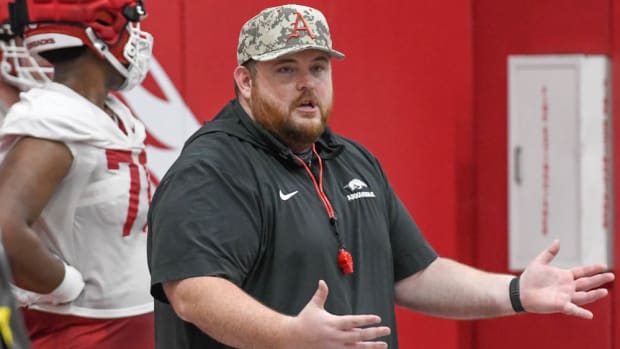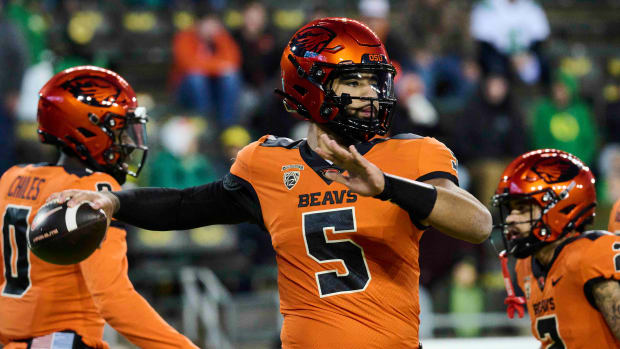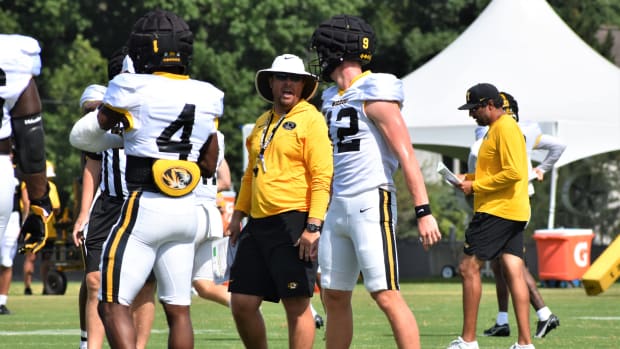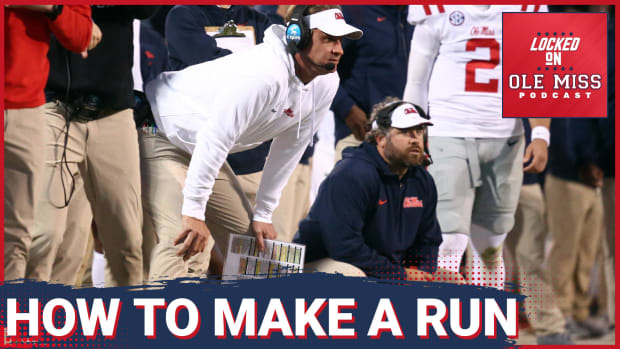A History-Making Playoff Selection Day Still Has a Familiar Face at the Top
The best four teams? That turned out to be the easy part. From a goal-line stand in Arlington to an upset romp in Atlanta to expected double-digit victories in Cincinnati and Indianapolis, the College Football Playoff field tidily sorted itself out on the final day.
Putting those four in order? That was the hard part, with legitimate debates at both the top and bottom of the bracket. The differences between No. 1 Alabama and No. 2 Michigan look close on paper but CFP selection committee chair Gary Barta said there was “strong consensus” in having the Crimson Tide ahead of the Wolverines. The difference between No. 3 Georgia and No. 4 Cincinnati might have been closer.
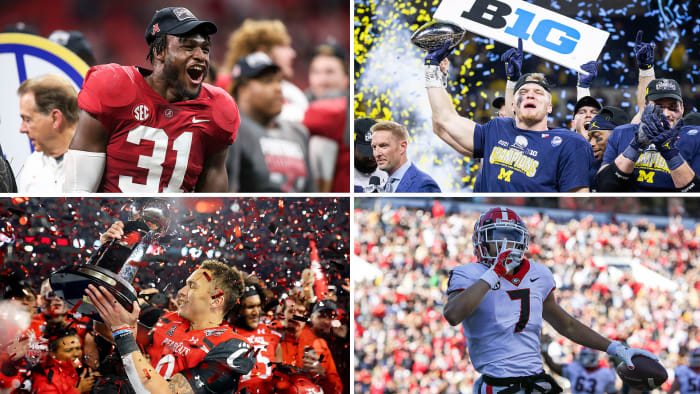
(Clockwise) Alabama's Will Anderson Jr, Michigan's Aidan Hutchinson, Georgia's Jermaine Burton and Cincinnati's Desmond Ridder.
Brett Davis; Trevor Ruszkowski; Kareem Elgazzar/USA TODAY NETWORK
After weeks of self-inflicted credibility wounds through the nonsensical Tuesday night ESPN TV show, the committee wound up getting the 1–4 ranking correct—right teams, right order. That sets the stage for a couple of delicious semifinals: Alabama–Cincinnati in the Cotton Bowl; Michigan–Georgia in the Orange Bowl. There was history made Sunday in multiple ways.
- The majority of the Power 5 conferences were excluded from the Playoff for the first time. The Big 12, Atlantic Coast and Pac-12 were all shunned in favor of two from the Southeastern Conference, one from the Big Ten and one from the American. The average number of P5 conference represented in the previous seven interactions of the playoff is 3.6; this year it is two. If that doesn’t get the commissioners of the excluded power leagues in high gear to advocate for a 12-team Playoff, nothing will. The SEC and Big Ten continue to widen the gap on the rest of the country, and the best opportunity to narrow that is to get more league champions in the Playoff with a chance to knock those two leagues off.
- The Bearcats finally broke the Group of 5 conference ceiling. The previous 28 CFP bids had gone to Power 5 teams, and three of the four this year have as well. Nor had a G5 team ever played in the playoff precursor, the BCS championship game. After decades of seeing undefeated G5 teams left out of the national championship chase, this is a momentous occasion and a populist blow.
- Michigan broke its own self-imposed ceiling of underachievement, finally making the Playoff after winning the Big Ten championship for the first time in 18 years. The Wolverines are the first team to go from unranked in the preseason polls to the Playoff, capping a tremendous rebuild from last year’s 2–4 bust. The sport is better when the Wolverines matter—and when someone from the Big Ten other than Ohio State is represented—and now they do again. Jim Harbaugh’s seventh season on the job is, at last, the payoff so many envisioned for him when he was hired.
Despite Barta’s claim that there was “strong consensus” for Alabama at No. 1 over Michigan, the comparison on paper is at least relatively close. The Wolverines could at least have an argument, starting with a better loss.
Even though the Sagarin Ratings say otherwise, Michigan’s four-point defeat at 10–2 Michigan State holds up better than the Crimson Tide’s three-point loss at 7–5 Texas A&M—games where both Playoff teams lost leads in the fourth quarter. But in terms of ranking victories against .500 or better opponents, it’s all Bama.
Alabama 41, Georgia 24 vs. Michigan 42, Ohio State 27: advantage Crimson Tide. Sagarin Ratings: Georgia No. 2, Ohio State No. 3.
Alabama 42, Mississippi 21 vs. Michigan 38, Wisconsin 17: advantage Crimson Tide. Sagarin Ratings: Ole Miss No. 11, Wisconsin No. 12.
Alabama 24, Auburn 22 vs. Michigan 21, Penn State 17: advantage Wolverines. Sagarin Ratings: Penn State No. 16, Auburn No. 25.
Alabama 42, Arkansas 35 vs. Michigan 42, Iowa 3: advantage Wolverines. Sagarin Ratings: Iowa No. 20, Arkansas No. 28.
Alabama 20, LSU 14 vs. Michigan 59, Maryland 18: advantage Crimson Tide. Sagarin Ratings: LSU No. 31, Maryland No. 77.
Alabama 49, Mississippi State 9 vs. Michigan 47, Western Michigan 14: advantage Crimson Tide. Sagarin Ratings: Mississippi State No. 32, Western Michigan No. 79.
Alabama 52, Tennessee 24 vs. Michigan 63, Northern Illinois 10. advantage Crimson Tide. Sagarin Ratings: Tennessee No. 33, Northern Illinois No. 92.
Alabama 42, Miami 13 vs. nothing: advantage Crimson Tide. Sagarin rating: Miami No. 36.
Alabama 31, Florida 29 vs. nothing: advantage Crimson Tide. Sagarin rating: Florida No. 40.
The Georgia–Cincinnati debate is a little frothier for a couple of reasons: the Bearcats have the better record (13–0 vs. 12–1) and the best win (by double digits at Notre Dame vs. a touchdown victory over Clemson at a neutral site). After those two facets, everything turns more toward the Bulldogs. Georgia’s next five victories over .500 or better opponents all are better (per Sagarin) than Cincy’s No. 2 win, which was Saturday over Houston. Then there is the matter of Georgia destroying everything in its path between Clemson and Alabama, while the Bearcats had some serious struggles against inferior opponents.
There was a lot of simmering over the weekend about whether the committee would actively try to avoid a rematch of Georgia and Alabama in a semifinal. Barta refuted that as a motivation for the committee.
“We don’t look at matchups,” he said. “We just look at who belongs No. 1, 2, 3 and 4.”
The numbers above bear that out, which sent the conspiracy theorists down their next rabbit hole: the committee is trying to grease the skids for another all-SEC title game, a callback to the 2017 Alabama–Georgia thriller. That makes no sense.
The makeup of the committee does not favor the SEC. And if motivated by ratings, those figure to be far higher if Michigan makes the championship game than Georgia.
If the rest of the nation would like to avoid an Alabama repeat national title and an all-SEC final, the path to that is simple: beat the Tide and Bulldogs in the semifinals. Simple, but not easy.
More College Football Coverage:
• Georgia's Narrative Resets After Another Loss to Bama
• Alabama's O-Line Came Up Huge vs. Georgia
• Dave Aranda's Meteoric Rise Hits a New Peak
• Inside the Wild Week That May Change CFB Forever

